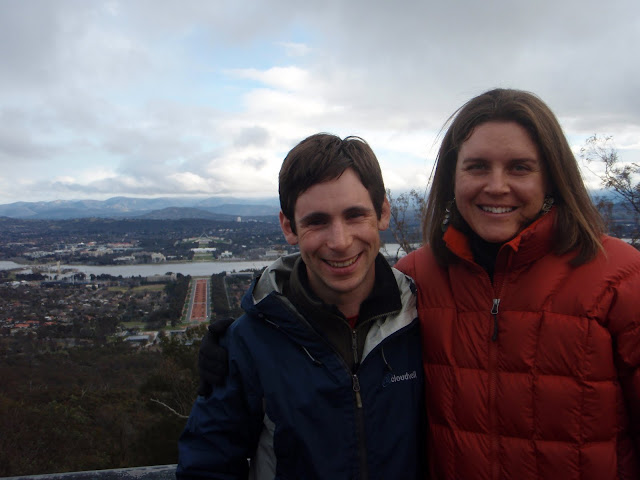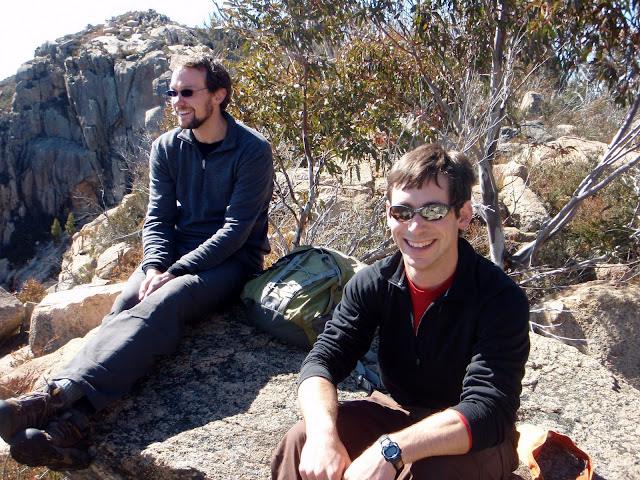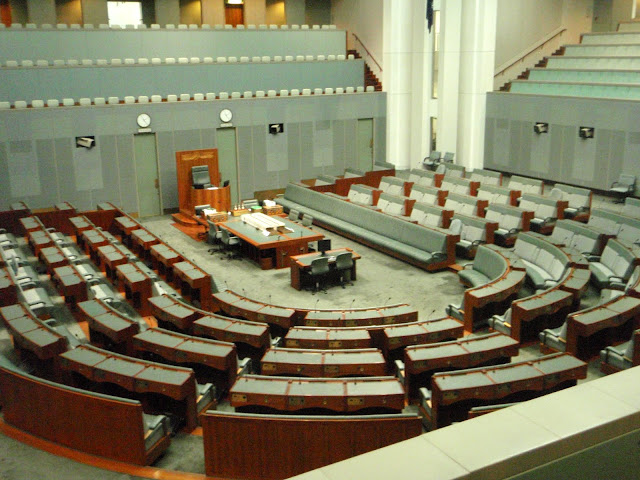Canberra feels like a capitol -- the architect (Walter Burley Griffin) was an American, and he definitely drew some of his inspiration from Washington D.C. Lots of monuments, lots of museums, lots of streets with funny names in funny configurations, lots of young professionals drawn from other parts of the country to run the government and its attendant structures. However, Canberra blends into its surroundings much better than any capitol city I have ever been to, containing large tracts of open un-manicured space and melting into the hills that surround it (this may have something to do with the fact that Burley Griffin was a student of Frank Lloyd Wright). In fact, Canberra surrounds and is built on several hills, reminiscent of another hilly capitol city.
Wednesday, 8 September 2010
The Nation's Capital
For those of you who don’t know (and I certainly didn’t), Canberra is the capital of Australia. We’ve heard a variety of explanations for why Canberra is where it is (apart from Alice Springs, I think it’s the only major Australian city that’s not along the coast). I think the main consensus is that Sydney and Melbourne couldn’t agree about which should be the capital, so they compromised and made a new city in between the two. The city is not that old (early 20th century), and is a planned city, which you definitely notice when you’re there. For one, the bike lanes are much better than in Adelaide, and there are lots of roundabouts! Also, each little suburb has its own set of shops to which most residents of the suburb can walk (which is actually fairly common in Australia, and a great idea I think!).
 We had the chance to go to Canberra for my Fulbright orientation session. I know you’re probably wondering why I’m having an orientation session more than half way through my time here, but the reason is because I actually missed the one for my scholarship year. Most scholars arrive in August, and so they schedule the orientation session to coincide with that. However, I came in January, and so missed last year’s program. So, I got to come along for this year’s session, which was great, even though I already knew a lot of the information shared.
We had the chance to go to Canberra for my Fulbright orientation session. I know you’re probably wondering why I’m having an orientation session more than half way through my time here, but the reason is because I actually missed the one for my scholarship year. Most scholars arrive in August, and so they schedule the orientation session to coincide with that. However, I came in January, and so missed last year’s program. So, I got to come along for this year’s session, which was great, even though I already knew a lot of the information shared.
Canberra feels like a capitol -- the architect (Walter Burley Griffin) was an American, and he definitely drew some of his inspiration from Washington D.C. Lots of monuments, lots of museums, lots of streets with funny names in funny configurations, lots of young professionals drawn from other parts of the country to run the government and its attendant structures. However, Canberra blends into its surroundings much better than any capitol city I have ever been to, containing large tracts of open un-manicured space and melting into the hills that surround it (this may have something to do with the fact that Burley Griffin was a student of Frank Lloyd Wright). In fact, Canberra surrounds and is built on several hills, reminiscent of another hilly capitol city.
 We had a great time at the orientation session, and especially enjoyed getting to meet the other Fulbrighters. We’re particularly excited because Dustin, one of the new scholars, is studying water policy and he and his wife, Heather, are going to be based in Adelaide. Very exciting! In fact, I had the chance to go hiking with Heather up Mt. Tennent in Canberra. It was a beautiful day and a lovely hike.
We had a great time at the orientation session, and especially enjoyed getting to meet the other Fulbrighters. We’re particularly excited because Dustin, one of the new scholars, is studying water policy and he and his wife, Heather, are going to be based in Adelaide. Very exciting! In fact, I had the chance to go hiking with Heather up Mt. Tennent in Canberra. It was a beautiful day and a lovely hike.
 The highlight of our time in Canberra was definitely getting to spend time with Gabe, Dave’s friend from college who is living in Canberra and working for Geoscience Australia. Gabe showed us around Canberra, taking us to Namadgi National Park, the Old Bus Depot markets, the National Library, and Brodburger, a Canberra institution. Brodburger makes and sells gourmet hamburgers from what looks like a gypsy caravan (garish red paint and all) down by the lake. Interestingly, some other businesses are trying to oust Brodburger (or at least to make them move to another less visible location) because they claim that Brodburger is stealing their business, and doesn’t look very nice (read: not sanitized suburbian upper middle class-looking) near the lake. However, all the locals (Canberrans) love Brodburger, and have rallied to save the little trailer-cum-restaurant because they love the food and the convenience. We, too, thoroughly enjoyed our chicken and brie brodburgers, and even signed the petition to help keep Brodburger right where it is!
The highlight of our time in Canberra was definitely getting to spend time with Gabe, Dave’s friend from college who is living in Canberra and working for Geoscience Australia. Gabe showed us around Canberra, taking us to Namadgi National Park, the Old Bus Depot markets, the National Library, and Brodburger, a Canberra institution. Brodburger makes and sells gourmet hamburgers from what looks like a gypsy caravan (garish red paint and all) down by the lake. Interestingly, some other businesses are trying to oust Brodburger (or at least to make them move to another less visible location) because they claim that Brodburger is stealing their business, and doesn’t look very nice (read: not sanitized suburbian upper middle class-looking) near the lake. However, all the locals (Canberrans) love Brodburger, and have rallied to save the little trailer-cum-restaurant because they love the food and the convenience. We, too, thoroughly enjoyed our chicken and brie brodburgers, and even signed the petition to help keep Brodburger right where it is!
 It was certainly an interesting time to be in Canberra. For those of you who aren’t following Australian politics closely, the country still does not have a Government two weeks after the election. Usually, the Fulbright orientation program includes an opportunity to go to Question Time with the Prime Minister. However, since there is no Prime Minister at the moment, we got to have a tour of the Parliament House (which was empty of politicians) and also went to the National Museum of Australia. There we went to an excellent exhibit on the Canning Stock Route, which was an old cattle route in Western Australia. It was not really very successful at all, but we learned about the rather sad history and interactions between Aboriginals and European Australians when the latter were trying to establish the route. Though it wasn’t a particularly pleasant topic, the exhibit is one of the best I’ve seen—highly interactive and engaging and definitely recommended if you happen to be in Canberra. (More pics here.)
It was certainly an interesting time to be in Canberra. For those of you who aren’t following Australian politics closely, the country still does not have a Government two weeks after the election. Usually, the Fulbright orientation program includes an opportunity to go to Question Time with the Prime Minister. However, since there is no Prime Minister at the moment, we got to have a tour of the Parliament House (which was empty of politicians) and also went to the National Museum of Australia. There we went to an excellent exhibit on the Canning Stock Route, which was an old cattle route in Western Australia. It was not really very successful at all, but we learned about the rather sad history and interactions between Aboriginals and European Australians when the latter were trying to establish the route. Though it wasn’t a particularly pleasant topic, the exhibit is one of the best I’ve seen—highly interactive and engaging and definitely recommended if you happen to be in Canberra. (More pics here.)
Canberra feels like a capitol -- the architect (Walter Burley Griffin) was an American, and he definitely drew some of his inspiration from Washington D.C. Lots of monuments, lots of museums, lots of streets with funny names in funny configurations, lots of young professionals drawn from other parts of the country to run the government and its attendant structures. However, Canberra blends into its surroundings much better than any capitol city I have ever been to, containing large tracts of open un-manicured space and melting into the hills that surround it (this may have something to do with the fact that Burley Griffin was a student of Frank Lloyd Wright). In fact, Canberra surrounds and is built on several hills, reminiscent of another hilly capitol city.
Subscribe to:
Post Comments (Atom)

No comments:
Post a Comment